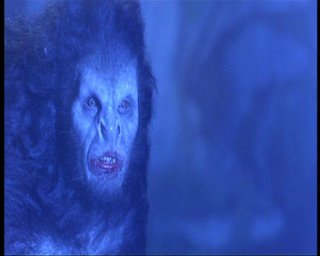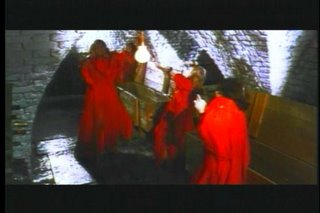
Rather than look at a specific movie, I thought it apt to have a look at some of the “rules” used to determine whether a movie is a vampire movie or not. The more we look at this, the more inconsistency we find, so this little foray into the “rules” carries two guarantees; firstly there are no definitive answers here and, secondly, there are going to be aspects and indicators missed.
Fangs: Oft quoted but not necessarily always used in vampire movies. Certainly there are no fangs in either The Hunger (1983) or “Near Dark” (1987) yet they are both, most definitely, vampire movies. Other film have alternative methods of feeding, such as the barbed proboscis that emerges from the armpit in “Rabid” (1977) a film often listed as a vampire movie. That said, fangs are often a good indicator.
Changing shape: There are, unfortunately, many supernat ural creatures which can change shape. The vampire’s ability to become wolfen, as in the still from “Bram Stoker’s Dracula” (1992), often clashes with the werewolf genre, but this should be of no surprise as the werewolf and vampire myths are closely linked in certain parts of the world. Less common, however, is the ability to become mist and almost always exclusive to the vampire genre is the ability to become a bat.
ural creatures which can change shape. The vampire’s ability to become wolfen, as in the still from “Bram Stoker’s Dracula” (1992), often clashes with the werewolf genre, but this should be of no surprise as the werewolf and vampire myths are closely linked in certain parts of the world. Less common, however, is the ability to become mist and almost always exclusive to the vampire genre is the ability to become a bat.
Drinking blood and other sorces of nutrition: A difficult one. Blood drinking seems to be a pre-requisite, but sometimes other feeding patterns emerge. This can include flesh eating, which, whilst similar to the zombie genre, is legitimate within the vampire genre as some vampire legends had flesh eating as part of the modus operandi. Psychic vampirism may come into a film, as could wholesale sucking the life force from a victim, the film “Lifeforce” (1986) being a prime example of this. On the other hand a film might have a creature obsessed with blood who is not a vampire. Is it simple enough to break this down and suggest that a vampire can be any form of parasite? Not really. Blood drinking is a good indicator, however.
Holy symbols, garlic and stakes etc: This one is really a toughie. Firstly the symbols and items also affect other creatures – so a cross would affect a demon or silver would affect a werewolf, and let’s face it a stake in the heart will kill a mortal as quickly as it would kill the undead. Also film makers twist the rules as they want. In the “Lost Boys” (1987), as an example, not only does garlic not work but the rule is invented that all the devices and items are rendered useless if the vampire is invited inside.
The Walking Dead: This is a real area of confusion. Certainly there are similes between the zombie and the vampire, No more so than in “The Living Dead Girl” (1982) which is a real hybrid of the two genres. My rule of thumb has always tended to be that if the returned dead is cognizant, preferably with memory, then it is more likely to be a vampire rather than a zombie. Other aspects to consider here is that the vampire tends to be a creature filled with lust were the zombie does not and the vampire can regenerate whereas the zombie rots. These basic premises do not always work, however, and there are also a myriad other forms of the walking dead.
Running water: Little used, but part of the genre, is the vampire ’s aversion to running water. Le Fanu uses this devise in "Carmilla as does Stephen King, at least in passing, in “’Salem’s Lot”. Hammer fell back on this one a couple of times and the illustrative screen shot is from “the Satanic Rites of Dracula” (1973) as the "brides" are doused in water from a sprinkler.
’s aversion to running water. Le Fanu uses this devise in "Carmilla as does Stephen King, at least in passing, in “’Salem’s Lot”. Hammer fell back on this one a couple of times and the illustrative screen shot is from “the Satanic Rites of Dracula” (1973) as the "brides" are doused in water from a sprinkler.
Sunlight: Again this is another difficult one. Whilst many films and books have the vampire tied to the night, many others do not. Bram Stoker allowed Dracula access to the daylight, also in “Two Orphan Vampires” (1995) the vampires are fully able to walk in daylight, though they are rendered blind. Burning in sunlight can, however, be a good indicator.
The Demon Aspect: Is it a vampire or is it a demon? The answer to that question was certainly blurred by “Buffy the Vampire Slayer” as the vampires are a certain type of demon which has taken residence in a body. Often the incubus and the succubus are classed as vampires, though these demons are sexual in nature rather than blood drinkers.
Alien visitation: Quite a popular one from time to time. “Lifeforce” (1986) was certainly about alien creatures and the marvellous “Goke: Body snatcher from Hell” (1966) involved a human possessed by an alien creature. Hey, even Buck Rogers faced a space vampire. It can be, it seems, that your vampire can be an alien rather than a supernatural creature.
Supernatural or natural/science based: By this I mean either another race of creatures, called vampire, from Earth or vampires created by science. The second is most definitely popular. Currently we have a rash of films that cite retro-virus or genetic tampering, but even in the 50’s mad scientists were creating vampires in movies – Blood of Dracula (1957) for instance. Both this section and the one before just go to show that your vampire doesn’t have to be what we would think of as undead.
Creating others: This was a rule of thumb that I used when deciding that Lair of the White Worm (1988) was a vampire movie, but it is not always the best rule of thumb as many creatures from horror movies can create others of their kind, and both the werewolf and zombie often do this through their bite. It is also clear that if a bite is enough, or whether a transfer of energy or blood is needed, changes from film to film.
Pretending to be a vampire: This is one where certain films fall into the genre without having a vampire in the film. One prime example is “Mark of the Vampire” (1935) in which the vampires are actors. “Sherlock Holmes and the Case of the Sussex Vampire” by Sir Arthur Conan Doyle is another example but its screen version, “Sherlock Holmes and the Last Vampire” (1992), could well fall into the next category.
Believing you are a vampire: Slightly different and easier to  class as a vampire movie then one in which the protagonist simply pretends to be a vampire. Here we have such films as the very black comedy “Vampire’s Kiss” (1989) a film that leads to the marvellous scene, pictured, of Nicholas Cage wearing cheap fake fangs, as he convinces himself that he has been infected with vampirism.
class as a vampire movie then one in which the protagonist simply pretends to be a vampire. Here we have such films as the very black comedy “Vampire’s Kiss” (1989) a film that leads to the marvellous scene, pictured, of Nicholas Cage wearing cheap fake fangs, as he convinces himself that he has been infected with vampirism.
Village Hysteria: Sometimes it is not necessary to have someone pretending to be a vampire or even believing themselves to be one. A film such as “Isle of the Dead” (1945) is most definitely a vampire movie, though there is not a single vampire in it. This movie relies on the hysteria that, in the past, probably gave birth to the legends of vampire outbreaks.
But the book was about a vampire: Just because the source material was about vampires does not mean that the film is. A classic example of this is Richard Matheson’s “I am Legend”. Personally I would class “The last man on Earth” (1964) as a vampire movie, and this was based on the book, but so was “The Omega Man” 1971) and “Night of the Living Dead” (1968), neither of which are of the genre in my opinion.
But the title indicates it is a vampire movie: This is the worst reasoning for whether a film is of the vampire genre or not as there are some really misleading titles. Some films have multiple names, so “The Devil’s Nightmare” (1971) is also known as “Vampire Playgirls”, but you won’t find a single vampire. “Bloodsucker leads the Dance” (1975) is equally misleading, being a murder mystery within an almost psychedelic gothic framework, but again no vampires.
Saturday, March 18, 2006
Vamp or not? The rules of the game.
Posted by
Taliesin_ttlg
at
2:39 PM
![]()
Subscribe to:
Post Comments (Atom)
















9 comments:
I'm pretty traditional here. I think it has to have obvious influences of either Stoker or Nosferatu or I have a hard time classifying it as vampire. It can be vampire hybrid, but those are the source of true vamp fiction.
Mateo, I can respect the traditionalism - though I would say for a traditional view you'd have to include Le Fanu's Carmilla, the novella has had a great deal of influence - including, probably, an influence on Stoker's work.
Your quandry here is a genuine one. In this modern age every piece of classic vampire mythology mythology is debatable or discardable depending on the author or film maker. Even the staples of aversion to sunlight and blood drinking, which one might think uncontrovertable, have been tossed aside in certain vampire stories.
Suzi - then again, the ealier vampire stories (English language) did not mention sunlight as an issue. Later Carmilla and Dracula were weakened but not destroyed.
Even with this, at the earliest artistic sources, we have controversy - I think that is what makes the genre so interesting.
I have to toss in my two pence when it comes to sunlight being regarded as a staple. This is mostly the domain of movies. (Then of course, certain literatures picked it up heavily.) It does provide some wonderful visual effects and weakness, but I admit it's a peeve of mine if someone says (and no one here did, mind) that a hard and fast vampire rule is no sunlight.
As I recall, even in some of the oldest folklore, vampiric beings did not necessarily burst into flames or such, in sunlight. Many were nocturnal, more active at night, yes—but it could be said a reason is because "all the bad things come out at night."
People's fear of what is in the dark...especially in an age of no electricity. If we look back at different folklore for any kind of malevolent being, they most often do their worst deeds at night.
Alright, I feel better. ;-)
S, feel free to toss two pence in whenever you like :)
Certainly, I agree, that sunlight was an invention of the movies (specifically Nosferatu) it has, through force of media consciousness become a genre staple.
I get wound up when folks say it can't be a vampire as it went out in the daytime/sunlight. Varney, Carmilla and Dracula all appeared in sunlight with no ill effect (to one degree or another) - so I know where you are coming from.
However, for the purposes of working out whether something falls in the vampire genre it is a one of many guage sticks - problem is there are, generally, no hard and fast rules for what a vampire can and can't do!
Oh, I understand needing some guidelines, and sunlight has been part of public's vision of vampires for a long time. Mostly I was recalling discussions where people were heard to say "but vampires could never go in the sun! You can't do that!"
While I'm all for some interesting twists on the legend when it's done well, I must confess that for me personally, there are two fairly non-negotiable points.
Fangs.
Drinking blood.
Something like The Hunger is an exception for me, because it was a great flick...there was still blood involved, too. Otherwise, I have to say I love the fangs.
Like yourself I feel that there should be blood and fangs (I'm an absolute sucker for fangs myself) - but there are exceptions that prove the rule, especially iro fangs. The hunger, as you mentioned and Near Dark are two of my favourite vamp movies... no fangs. Black Sunday is another favourite and Bava decided against fangs in the last minute... (that said, Isle of the Dead doesn't even have a vampire in it and is still a favourite!)
Near Dark wasn't bad.
Fangs make me weak in the knees, in a good way. ;-) Conversely, something like 30 Days of Night, or David Wellington's vamps, rows of lethal teeth up the blood chill factor.
Post a Comment